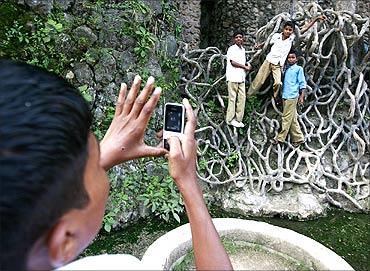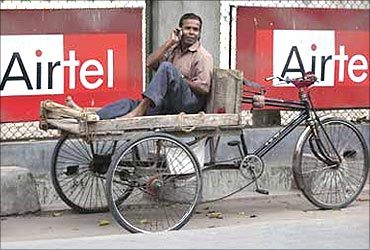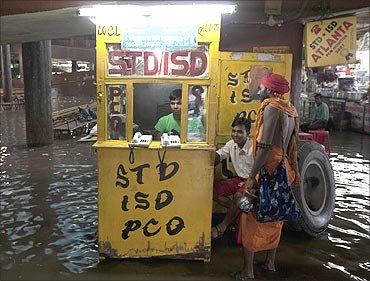Home »
Business » How India can ring in a telecom revolution
How India can ring in a telecom revolution
Last updated on: October 29, 2010 08:35 IST
Image: A schoolboy uses his cell phone to take a picture of classmates hanging onto cement roots at Nek Chand's Rock Garden in Chandigarh.
Photographs: Andrew Caballero/Reuters.
The rollout of telecom services has been phenomenal over the past few years. Tele-density has shot up from around 9 per cent in 2005 to 57 per cent in August 2010, with more than 15 million mobile phone subscribers added every month over the past year.
The rise in the number of mobile or wireless subscribers has been accompanied by a decline in landline or wireline connections, since people are giving up what once used to be a much sought-after phone connection.
Tele-density in the wireline and wireless segments was at similar levels of about 4 per cent coverage each in 2005; according to latest estimates for August 2010 while wireline tele-density is 3.02 per cent, wireless tele-density stands at 56.61 per cent.
...

Image: Prem (3), the son of an idol vendor, plays with a mobile phone
Photographs: Ajay Verma/Reuters.
There are, of course, certain caveats to celebrating this rise, e.g. in metros, many people would have multiple prepaid connections to their name.
This makes comparison across states problematic, especially when we see a near-200 per cent tele-density in Delhi-NCR service area and then compare it to the lowest figure of around 32 per cent in Assam, Bihar and Jharkhand.

Image: Tulsi Prasad, an Indian slum dweller, uses a mobile phone.
Rural India, of course, lags the cities. While rural tele-density has risen by 10 percentage points over the year to touch 25 per cent by June 2010, urban tele-density is up 47 percentage points over the same period year, at 120 per cent.
Rural tele-density is highest in Himachal Pradesh, Kerala, Punjab and Haryana, while Madhya Pradesh and Bihar service areas, which include Chhattisgarh and Jharkhand, have the lowest rural tele-density rates of less than 20 per cent.
...

Image: Common Service Centre run by the govt.
Photographs: Courtesy, CSC.
The Universal Service Obligation Fund created in 2002 to create infrastructure in rural areas has not delivered as promised, despite telecom operators paying 5 per cent of annual revenues towards this fund.
Internet penetration is another measure of connectivity. The number of internet users is estimated at 81 million, according to International Telecommunications Union data; and the Telecom Regulatory Authority of India sets the number of broadband subscribers at 10.08 million in August 2010.

Image: Rise in mobile phone susbcribers.
Photographs: Reuters.
The government programme of setting up Common Service Centres (CSC), one for every six villages, was launched in 2006, to facilitate e-governance, education, health, telemedicine and other services, through a private-public partnership.
The scheme is close to its target of covering all villages by March 2011; as of August 2010, 20 states have a more than 70 per cent rollout, three states have crossed the halfway mark and the remainder have more than half their target to cover.

Image: People sit in a flooded phone booth at a bus station after heavy rains in New Delhi.
Photographs: Enrico Fabian/Reuters.
Though there are many success stories from around the country, there are also many glitches - while Haryana reports 100 per cent CSC rollout, 561 out of the 1,159 CSCs are non-operational due to termination of the service centre agency. The situation is similar in some other states, so the actual rollout is different from the number stated.
Connectivity is set to expand across the country, especially with the mobile phone enabling internet access; however, despite the telecom sector being one of the fastest-growing sectors in India, there is ample scope and urgent need for reform and transparency.
It is a no-brainer that the future lies in ICT (information and communication technology), the faster and more complete the coverage, the better the prospects for inclusive growth and development.

Indian States Development Scorecard is a weekly feature by Indicus Analytics that focuses on the progress in India and the states across various socio-economic parameters.
Source:







![]()